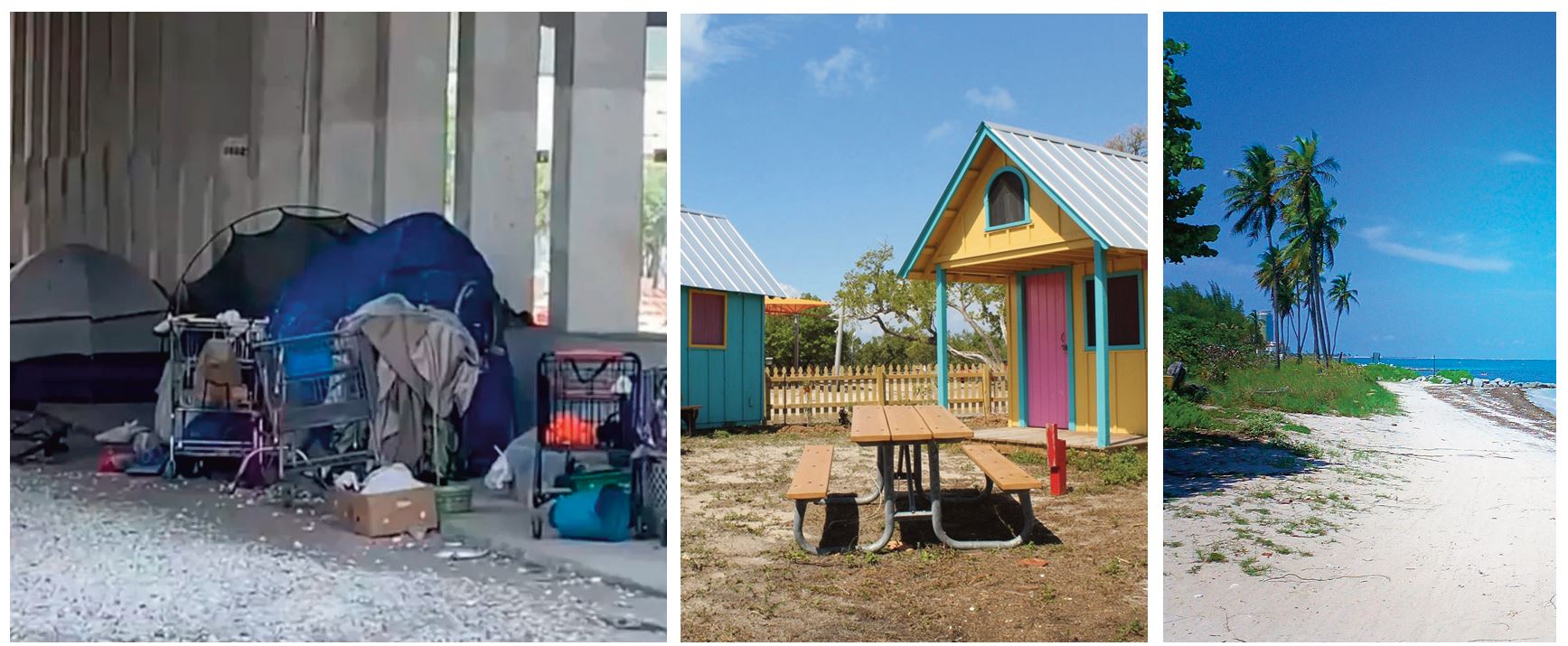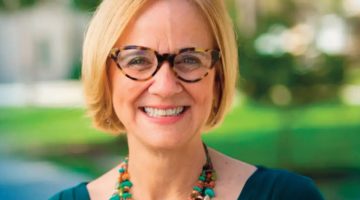Homeless in Miami. Historic Virginia Key Beach Park. PHOTOS COURTESY OF WIKIPEDIA, MIAMIRACIALEQUITY.ORG AND VIRGINIAKEYBEACHPARK.NET
Miami – A new state law that forces local governments to remove the homeless population from public places and put them into shelters could ignite a controversial plan by the City of Miami.
The 2020 proposal was designed to build 100 encampments for 200 chronic homeless people on Virginia Key and a social service center to help clean them up and teach them job skills.
The new state law doesn’t go into effect until Oct. 1 but government officials from the tri-county area are struggling to comply with the regulation’s ban on homeless people sleeping and camping out in the streets, parks and other public places.
If they refuse to go to shelters, they could be arrested.
As government officials are stressing over the legislation signed by Gov. Ron DeSantis, the City of Miami, which has one of the largest homeless populations in South Florida, may revisit a pilot program to place such people at the North Point of Virginia Key.
The plan, proposed by Vice Mayor Joe Carollo, drew so much backlash in 2022, that city commissioners withdrew it without further discussion, as protestors stood in and outside City Hall during two meetings denouncing it.
Blacks vehemently opposed the idea because it could jeopardize decades of efforts to restore the historic Virginia Key Beach, Miami’s only Colored Beach during segregation, including building a Black museum to honor trailblazers who had an impact on Miami’s history.
Virginia Key revitalization advocates and Key Biscayne residents also joined the protest, suggesting the proposal is not part of the revitalization master plan for the beach park, which is a tourism hub.
They said a homeless population on Virginia Key could cost the local economy millions of dollars a year.
The plan targeted people roaming the streets of Miami, and living in tents under I-95 and near Jackson Memorial Hospital, by placing them on an island miles away from drug and alcohol abuse programs with little public transportation running along the Rickenbacker Causeway.
Homeless people also rejected the proposal, saying it’s like a prison camp: placing them far away from family members, and from walking the city streets and enjoying the sights of Downtown Miami, Brickell and Coconut Grove.
The city officials told the South Florida Times in an email that “it’s premature for us to comment at this time” about plans to comply with the state requirements, which has people wondering if the city will revisit Virginia Key as the site for the homeless population.
Among three proposed sites for the homeless camp, Miami officials said in 2022 Virginia Key offers the largest chunk of land for the project, which is about 125,000 square feet and about 2.4 miles away from residential communities in Key Biscayne.
The other proposed sites were in Liberty City, on state-owned property under I-95 near NW 71st Street and 5th Place, and a privately-owned parcel in Allapattah.
Athalie L. Edwards, executive director of the Virginia Key Beach Park Trust, which was put in charge of restoration efforts and the museum, didn’t respond to a request to be interviewed.
Miami Commission Chairwoman Christine King, who’s also chair of the trust, said in a statement that she is not aware of any plans to revisit the initiative.
King said the 2020 proposal to address homelessness was never intended to include the historic Virginia Key Beach. “This location is on Virginia Key more than a mile away from the historic Black beach on an empty parking lot,” she said.
Patrick Range, former chair of the trust and the grandson of Athalie Range, the first Black woman Miami city commissioner, who led efforts to open Miami’s only Colored Beach, said he hadn’t heard any rumors about placing the homeless population on Virginia Key.
If the city does revisit the plan, he said he opposes it.
“It’s not a good plan because it goes against the spirit of revitalizing Virginia Key Beach,” he said. “It goes against building the Black museum.”
Range, an attorney, said if the city does reconsider the proposal, “The state law bans people from sleeping in the parks. Virginia Key Beach is a park,” he said. “Any plans for the homelessness would go against the new state law.”
Gene Tinnie, a local artist and community activist who was founding vice chair of the trust, said he wouldn’t be surprised if the city brings back the proposal.
“We are not going to solve this problem overnight but we may not have any solutions right now, but at least we know what is not a solution, so the whole discussion of a homeless concentration camp, on Virginia Key or anyplace else, needs to cease and desist now,” Tinnie said. “It is not an option.
“That is why the connection of Virginia Key to the real issue is secondary at best, even though the foolishness of the city commission in attempting to create a connection (which they have only deferred rather than terminate it) gives it a relevance that it does not deserve or deserve to have reinforced.”
Dr. Leah Kinnaird, co-founder of the Virginia Key Alliance, said she heard rumors about putting the homeless population on Virginia Key.
“We, the Virginia Key Alliance, remain concerned about any homeless encampment on Virginia Key, where resources will have to be built and where people will be isolated from community support,” she said. “Homeless people do not respond well to being locked or confined.”
Two years ago, a homeless encampment on Virginia Key and the removal of the entire trust members sparked concerns in the Black community over whether the Black museum will ever get built.
City commissioners ousted trust members and took over the board after blaming it for delaying construction of the museum for years.
In its first step of constructing the museum, the trust hosted a workshop last year to garner input from the community on the type of museum they want to see.
Miami officials hired Lord Cultural Resources, the international consulting firm responsible for the Black museum in Washington D.C., to help the city build the museum.
Tiffany Lyons, a consultant with the firm, said Miami earmarked $20 million for the building.
She said her firm is examining the input from the community and will develop and present a preliminary plan at a future workshop.
Lyons said it should take about 24 months to complete the project once the blueprints are approved by city commissioners.
“That is the next step to getting the center build,” she said.
Some people who participated in the workshop verbally committed funds ranging from $10,000 to $30,000 to build the museum.













No Comment